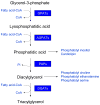Lipodystrophies: disorders of adipose tissue biology
- PMID: 19162222
- PMCID: PMC2693450
- DOI: 10.1016/j.bbalip.2008.12.014
Lipodystrophies: disorders of adipose tissue biology
Abstract
The adipocytes synthesize and store triglycerides as lipid droplets surrounded by various proteins and phospholipids at its surface. Recently, the molecular basis of some of the genetic syndromes of lipodystrophies has been elucidated and some of these genetic loci have been found to contribute to lipid droplet formation in adipocytes. The two main types of genetic lipodystrophies are congenital generalized lipodystrophy (CGL) and familial partial lipodystrophy (FPL). So far, three CGL loci: 1-acylglycerol-3-phosphate-O-acyltransferase 2 (AGPAT2), Berardinelli-Seip Congenital Lipodystrophy 2 (BSCL2) and caveolin 1 (CAV1) and four FPL loci: lamin A/C (LMNA), peroxisome proliferator-activated receptor gamma (PPARG), v-AKT murine thymoma oncogene homolog 2 (AKT2) and zinc metalloprotease (ZMPSTE24), have been identified. AGPAT2 plays a critical role in the synthesis of glycerophospholipids and triglycerides required for lipid droplet formation. Another protein, seipin (encoded by BSCL2 gene), has been found to induce lipid droplet fusion. CAV1 is an integral component of caveolae and might contribute towards lipid droplet formation. PPARgamma and AKT2 play important role in adipogenesis and lipid synthesis. In this review, we discuss and speculate about the contribution of various lipodystrophy genes and their products in the lipid droplet formation.
Figures



References
-
- Garg A. Lipodystrophies. Am J Med. 2000;108:143–152. - PubMed
-
- Misra A, Peethambaram A, Garg A. Clinical features and metabolic and autoimmune derangements in acquired partial lipodystrophy: report of 35 cases and review of the literature. Medicine. 2004;83:18–34. - PubMed
-
- Carr A. HIV protease inhibitor-related lipodystrophy syndrome. Clinical Infectious Diseases. 2000;30 2:S135–142. - PubMed
-
- Garg A. Acquired and genetic lipodystrophies. N Engl J Med. 2004;350:1220–1234. - PubMed
-
- Agarwal AK, Garg A. Genetic basis of lipodystrophies and management of metabolic complications. Annu Rev Med. 2006;57:297–311. - PubMed
Publication types
MeSH terms
Substances
Grants and funding
LinkOut - more resources
Full Text Sources
Medical
Molecular Biology Databases
Miscellaneous

